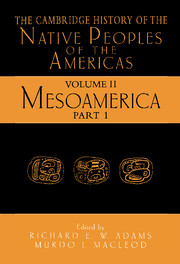Book contents
- Frontmatter
- Contents
- List of Illustrations
- Part I
- 1 Introduction to a Survey of the Native Prehistoric Cultures of Mesoamerica
- 2 The Paleoindian and Archaic Cultures of Mesoamerica
- 3 The Preclassic Societies of the Central Highlands of Mesoamerica
- 4 The Precolumbian Cultures of the Gulf Coast
- 5 The Maya Lowlands: Pioneer Farmers to Merchant Princes
- 6 The Central Mexican Highlands from the Rise of Teotihuacan to the Decline of Tula
- 7 Western and Northwestern Mexico
- 8 Cultural Evolution in Oaxaca: The Origins of the Zapotec and Mixtec Civilizations
- 9 The Southeast Frontiers of Mesoamerica
- 10 The Maya Highlands and the Adjacent Pacific Coast
- 11 The Aztecs and Their Contemporaries: The Central and Eastern Mexican Highlands
- Index
3 - The Preclassic Societies of the Central Highlands of Mesoamerica
Published online by Cambridge University Press: 28 March 2008
- Frontmatter
- Contents
- List of Illustrations
- Part I
- 1 Introduction to a Survey of the Native Prehistoric Cultures of Mesoamerica
- 2 The Paleoindian and Archaic Cultures of Mesoamerica
- 3 The Preclassic Societies of the Central Highlands of Mesoamerica
- 4 The Precolumbian Cultures of the Gulf Coast
- 5 The Maya Lowlands: Pioneer Farmers to Merchant Princes
- 6 The Central Mexican Highlands from the Rise of Teotihuacan to the Decline of Tula
- 7 Western and Northwestern Mexico
- 8 Cultural Evolution in Oaxaca: The Origins of the Zapotec and Mixtec Civilizations
- 9 The Southeast Frontiers of Mesoamerica
- 10 The Maya Highlands and the Adjacent Pacific Coast
- 11 The Aztecs and Their Contemporaries: The Central and Eastern Mexican Highlands
- Index
Summary
BACKGROUND
The tall mountain ranges of the Sierra Madre Occidental and Oriental parallel the west and east coasts of northern Mexico. Near that country’s midsection they are connected by a more recent mountain chain of volcanic origin that runs east-west across Mexico from nearly coast to coast. The uniting of those three mountain masses creates a vast highland (altiplano) region in central Mexico, characterized by lofty mountains, well-watered valleys, and temperate climates. A cultural focal point during much of the prehistory of that region has been the Basin of Mexico, a broad interior valley at an elevation of 2,200 meters. Two of Mexico’s tallest volcanos, Iztaccihuatl (“White Woman”; 5,230 m) and Popocatepetl (“Smoking Mountain”; 5,465 m), loom over the southeastern fringes of the Basin, and modern Mexico City today spreads across the Basin floor and into the foothills. The tall mountains that surround the Basin now serve to enclose and contain the air pollution produced by one of the world’s largest cities, while in prehispanic times those same encircling characteristics entrapped all waters to create an extensive but shallow lake across the valley floor that attracted animals and humans alike. At the arrival of the Spanish in 1519 the lake was the location of the powerful Aztec island city of Tenochtitlan, precursor to modern Mexico City.
Not far to the north of the Basin is Mexico’s great northern desert, a region of low rainfall and a land where agriculture was usually impossible. Extending as a lobe northeastward from the Basin is the Teotihuacan Valley, location of one of Mexico’s great Classic period cities. Beyond the mountains to the south are the extensive river valley systems of the states of Puebla, Tlaxcala, Morelos, and Guerrero, regions generally characterized by lower altitudes, temperate to subtropical climates, and fertile soils. Because of the central highlands’ proximity to Mexico’s arid northern desert, only the Basin’s south and southwestern areas, and the river valleys beyond the mountains, provided the circumstances appealing to early farmers.
The geological complexity of the central highlands is matched by its great ecological diversity, the latter owing to rapid variations in elevation, rain shadow patterns, soil types, humidity, and the like. Those features combined to provide an unusually abundant and varied set of resources and materials available for exploitation by the societies there.
- Type
- Chapter
- Information
- The Cambridge History of the Native Peoples of the Americas , pp. 122 - 155Publisher: Cambridge University PressPrint publication year: 2000
- 12
- Cited by



